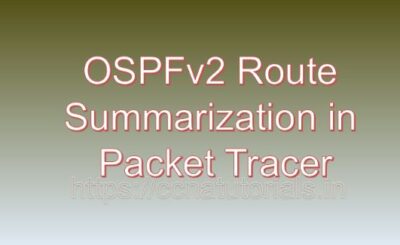Contents of this article
In this article, I describe the process of OSPFv2 Route Summarization in Packet Tracer. Open Shortest Path First version 2 (OSPFv2) is a widely used routing protocol in computer networks due to its scalability, fast convergence, and robustness. One of the key features of OSPFv2 is route summarization, which helps reduce the size of routing tables and control the propagation of routing information. In this article, we’ll explore how to configure OSPFv2 route summarization in Packet Tracer, a versatile network simulation tool, along with a practical example.
Understanding OSPFv2 Route Summarization
Route summarization, also known as route aggregation, involves consolidating multiple contiguous network addresses into a single summarized address. This summarized address is advertised as a single route, reducing the size of routing tables and minimizing routing overhead. OSPFv2 supports route summarization at area borders, allowing network administrators to control the dissemination of routing information within OSPF domains.
Benefits of OSPFv2 Route Summarization
- Reduced Routing Table Size: By summarizing multiple routes into a single route advertisement, OSPFv2 route summarization conserves memory and CPU resources on routers, improving overall network performance.
- Controlled Propagation: Route summarization enables network administrators to control the propagation of routing information and reduce the scope of OSPF updates, leading to more efficient network operation.
- Enhanced Scalability: With OSPFv2 route summarization, networks can scale more effectively, accommodating growth without excessively increasing routing overhead. Configuring OSPFv2 Route Summarization in Packet Tracer
Let’s dive into the practical implementation of OSPFv2 route summarization using Packet Tracer.
Step 1: Designing the Network Topology
Begin by designing a network topology that includes routers and network segments. Ensure that OSPFv2 is configured and enabled on all routers within the OSPF domain.
Step 2: Identifying Summarization Points
Identify the points in your network where route summarization will be applied. Typically, summarization occurs at area boundaries in OSPFv2. Choose routers that serve as area border routers (ABRs) where routes from multiple areas converge.
Step 3: Configuring Route Summarization
On the ABR routers, configure OSPFv2 route summarization using the following commands:
Router(config) router ospf [process-id]
Router(config-router) area [area-id] range [summary-address] [mask]Replace [process-id] with the OSPF process ID, [area-id] with the OSPF area ID, [summary-address] with the summarized network address, and [mask] with the subnet mask for the summarized address.
Step 4: Verifying Route Summarization
Verify the configuration by examining the routing tables on routers within the OSPF domain. Use commands such as show ip route to view the summarized routes and ensure that they are propagated correctly.
Example Scenario: Route Summarization in a Corporate Network
Consider a corporate network with multiple branch offices interconnected via a backbone network. Each branch office has its own subnet, and OSPFv2 is used as the routing protocol. To improve network efficiency, OSPFv2 route summarization is implemented at the backbone routers, summarizing the routes for each branch office subnet into a single advertisement.
Conclusion for OSPFv2 Route Summarization in Packet Tracer
OSPFv2 route summarization is a powerful technique for optimizing routing table size and controlling the propagation of routing information in OSPF domains. By configuring route summarization in Packet Tracer, network administrators can gain hands-on experience with this essential OSPFv2 feature. Whether you’re managing small-scale networks or large enterprise infrastructures, OSPFv2 route summarization offers significant benefits in terms of network efficiency, scalability, and manageability. With Packet Tracer, mastering OSPFv2 route summarization is both educational and practical, empowering you to optimize OSPFv2 deployments in real-world network environments.
I hope you found this article helpful related to OSPFv2 Route Summarization in Packet Tracer. You may drop a comment below or contact us for any queries of suggestions about the contents of this website.






